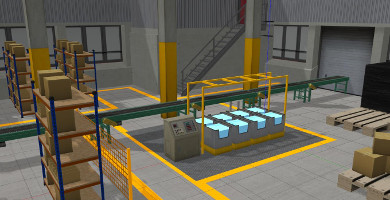Agile Robotics for Industrial Automation Competition
ARIAC

Overview
General information
This landing page is targeted toward participants of the Agile Robotics for Industrial Automation Competition (ARIAC). Contained here is general information about ARIAC, and links to important resources.
The objective of the Agile Robotics for Industrial Automation Competition (ARIAC) is to test the agility of industrial robot systems, with the goal of enabling industrial robots on the shop floors to be more productive, more autonomous, and be more responsive to the needs of shop floor workers.
Year 1 of the competition in 2017 focused on pick-and-place kit assembly operations. Year 2 will focus on order fulfillment. Qualifiers are expected to begin in March 2018 with the final competition held in May 2018.
Gazebo will provide the simulation infrastructure. A custom set of models, plugins and scripts will be used to simulate an industrial setting with a robot arm and dynamic objects.
Announcements
We are proud to announce that registration for ARIAC 2018 is now open! The registration form can be found here.
The ARIAC 2017 Finals have wrapped up and the results have been announced (see below).
Top-performing teams will be presenting at IROS 2017 in Vancouver, Canada in a workshop held on Sunday, September 24th. Details for interested parties are available on the NIST website.
The IROS workshop is open to all, even those that did not compete. In addition to having presentations about approaches used in the competition, we will also be exploring plans for future competitions. If you would like to give a presentation about agility challenges you would like to see in future competitions, please contact Craig Schlenoff.
Congratulations to all teams that participated in the competition. We look forward to seeing you in Vancouver!
Results of the ARIAC 2017 Finals
The virtual nature of the ARIAC competition enabled participation of teams affiliated with companies and research institutions from across three continents. While autonomously completing pick-and-place kit assembly tasks, teams were presented with various agility challenges developed based on input from industry representatives. These challenges include failing suction grippers, notification of faulty parts, and reception of high-priority orders that would prompt teams to decide whether or not to reuse existing in-progress kits.
Teams had control over their system’s suite of sensors positioned throughout the workcell, made up of laser scanners, intelligent vision sensors, quality control sensors and interruptible photoelectric break-beams. Each team participating in the finals chose a unique sensor configuration with varying associated costs and impact on the team’s strategy.
The diversity in the teams’ strategies and the impact of their sensor configurations can be seen in the video of highlights from the finals:
Scoring was performed based on a combination of performance, efficiency and cost metrics over 15 trials. The overall standings of the top teams are as follows.
First place: Realization of Robotics Systems, Center for Advanced Manufacturing, University of Southern California
Second place: FIGMENT, Pernambuco Federal Institute of Education, Science, and Technology / Federal University of Pernambuco
Third place: TeamCase, Case Western Reserve University
If you're interested in trying your hand at the scenarios used in the Finals, all of the information is available on the ARIAC wiki.
Qualifiers
To qualify to enter the competition, you first need to demonstrate your team's potential by completing at least one qualifying task. The first qualifier will be released in March 2018, with additional qualifiers to be released at set intervals leading up to the competition. The qualifiers will increase in complexity and difficulty over time, moving competitors toward the challenge of the full competition.
How a qualifier works: You participate in a qualifier remotely, using your own computer. We will provide instructions for how to download and install a particular version of the ARIAC software. You'll use our software together with your own code to complete a specified task, and then upload evidence of your work (e.g., data logs).
Code
The code needed to participate in ARIAC is available at https://bitbucket.org/osrf/ariac
Help
Sources of support
We strive to provide responsive and high-quality support for our software. Please refer to the following list of our support resources to find the right avenue for help and information.
- Wiki: Tutorials, documentation, and other useful information.
- ROS Discourse: A place for general discussion and questions about ARIAC.
- Issue tracker: A resource to submit and follow feature requests, bugs, and enhancements.


